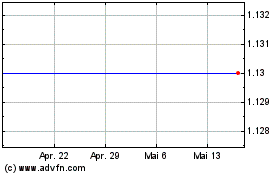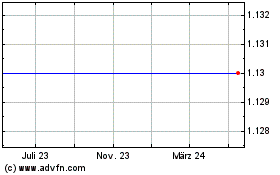Asanko Gold Inc. (“Asanko” or the “Company”) (TSX, NYSE
American: AKG) is pleased to provide an update on the work
underway to update the Mineral Resource and Reserve Estimate for
the Asanko Gold Mine (“AGM”), located in Ghana, West Africa. The
AGM is a 50:50 joint venture (“JV”) between Asanko and Gold Fields,
which is operated by Asanko.
Following a recent planning session between the
AGM JV partners, key decisions were made and agreed between the
parties as to the basis for an updated Mineral Resource and Reserve
Estimate which is expected to be effective as at December 31, 2019
and published in Q1 2020.
Key Scope Items:
- Mine plan based on the open pit Mineral Reserves at Esaase and
Nkran (reflecting Cut 2 with stripping now nearing completion and a
further Cut 3 pushback) as well as Mineral Resources from satellite
pits at Akwasiso, Adubiaso, Abore and Asuadai;
- Production based on the existing processing plant and
infrastructure treating 5.4 million tonnes per annum (“Mtpa”) of
ore;
- Targeting a remaining life of mine of 8-10 years with gold
production of 225,000 to 250,000 ounces per year;
- Mineral resource models for all pits based on Localized Uniform
Condition (LUC) methodology which has been proven over the last 12
months of operations to provide reliable reconciliation with
mining;
- Classification of Mineral Resources will be based on NI 43-101
standards and consistent with Gold Fields’ operating
practices;
- Mineral Reserve estimates to be generated based on Measured and
Indicated Mineral Resources using Datamine Mine Stope Optimizing
(MSO) software which has been demonstrated in operations to provide
reliable estimates;
- Ore will continue to be transported from the Esaase pit to the
processing facility via road trucks. The existing 27km haul
road will be upgraded as required to support higher haulage rates
in the future;
- Significant capital expenditure is expected to be limited to
the relocation of the Tetrem village (commencing in Q3 2019), an
upgrade to the Esaase ore haul road (anticipated in 2022), waste
stripping of Nkran Cut 3 and ongoing Tailing Storage Facility
capital;
- Life of mine capital is not expected to include any major
development capital investments such as further processing plant
expansions or Esaase ore transportation infrastructure;
- Metallurgical recovery estimates for Esaase fresh ore based on
an updated metallurgical model developed by the AGM JV partners
based on a test-work program underway.
“We have now aligned our development philosophy
for the Asanko Gold Mine with our focus on near term free cash-flow
generation,” said Greg McCunn, Chief Executive Officer. “As a
result of the collaboration efforts of the joint Technical
Committee of the JV, the joint venture now has a clear road map to
complete this study in coordination with the year-end. Going
forward, we expect to provide annual updates to the Mineral
Resource and Reserve estimates.
The AGM is well positioned to generate positive
cash flow following the completion this quarter of the major
capital stripping program at Nkran. The updated life of mine plan
will give us the basis from which to continue to develop a long
life asset through our exploration strategy on the highly
prospective 21,000 hectare land package. There are numerous high
priority targets within trucking distance of the existing
facilities and with exploration drilling underway this quarter, we
expect to be profitably mining at the Asanko Gold Mine for a very
long time.”
Mineral Resource and Reserve
Estimate
Localised Uniform Conditioning (LUC) has been
adopted for mineral resource modelling at all deposits at the AGM.
This methodology has been proven over the last 12 months of
operations to provide reliable reconciliation with mining. The type
of mineralisation prevalent in the various open pits show a
juxtaposition of high grade mineralization in close proximity to
low grade mineralization and waste material. The adopted estimation
methodology was selected to limit risk of overestimation of tonnes,
and underestimation of grade that can happen when drill spacing is
still quite broad and linear estimation methodologies such as
Ordinary Kriging are used.
All deposit models have been updated with
geological domain boundaries and key mineralisation controlling
structures which have been derived from production grade control
models developed over the past 18 months of operation. Geological
modelling based on recent mining activity at the Esaase pit is
still being finalized and is expected to be completed in Q4
2019. The updated model
for Esaase includes a detailed re-investigation of the controls to
mineralization within the Esaase deposit which involved:
- drilling an additional 4,900m of reverse circulation (“RC”)
drilling (84 new RC holes) to more accurately delineate the surface
oxide,
- re-logging of 43,000m (163 holes) of historical diamond
drilling to improve the structural and lithological interpretation
of the controls to mineralization, including the development of new
wireframes, and
- reviewing the geostatistical modelling methodologies best
suited to Esaase.
In addition to the modelling updates, mineral
resource classification definitions have been adopted which are
more rigorous than previous classification definitions, and are now
consistent with those used by Gold Fields across other operations.
It is expected that some of the Mineral Resources at Esaase
categorized in 2017 as Measured and Indicated will be reclassified
as Inferred Mineral Resources and will require further infill
drilling in order to be classified as Indicated Resources.
Datamine Mine Stope Optimizing (MSO) software
which has been demonstrated in operations to provide reliable
estimates will be used to generate the Mineral Reserve estimates
based on the Measured and Indicated Mineral Resources. Adoption of
trucking transport solution will also increase the cut-off grade
utilised in the estimation of Mineral Reserves.
Metallurgical Test-work
As part of the approval of commencement of
mining activities at the Esaase deposit in early 2019, the JV
initiated a metallurgical test-work program to improve the
confidence in metallurgical recovery estimates for the fresh ore at
Esaase. Current mining operations are mining oxide ores from the
Esaase deposit, which represent approximately 30% of the resource.
Oxide ore recovery is well understood and approximately 30% of the
ore feed for the current operations is being sourced from Esaase
oxides with metallurgical plant recovery of gold of over 93%.
In future years, mining will progress through
the transition zone at Esaase and into fresh ore. Prior
metallurgical test-work undertaken on the Esaase deposit was
predominantly directed at a different metallurgical flowsheet which
included flotation ahead of carbon-in-leach gold recovery. The
recent infill drilling campaign was able to produce samples for a
metallurgical test-work program which has been underway in 2019. It
is expected that metallurgical test-work will continue throughout
2019 and 2020, well ahead of the expected processing of fresh ore
in the processing plant.
For the updated Mineral Resource and Reserve
estimate, a metallurgical model is being developed which will
incorporate estimates in overall recovery of gold from Esaase fresh
ore based on processing the ore in the existing processing
plant.
Gold Price Assumptions
Consistent with prior estimates, it is expected
that the Mineral Resources will be constrained to a US$1,500/oz pit
shell and the Mineral Reserves will be estimated using US$1,300/oz
gold price. A range of gold price sensitivities will be included in
the updated technical report.
Updated Technical Report
Given the described changes to the basis and to
the scope, the updated life of mine plan may be significantly
different from the previously stated life of mine plan set out in
the December 20, 2017 Definitive Feasibility Study (the “12/17
DFS”).
The anticipated reclassification of certain of
the Measured and Indicated Mineral Resources at Esaase to Inferred
Mineral Resources will result in a reduction in the number of
ounces which can then be classified as Proven and Probable Mineral
Reserves. This reclassification and the incorporation of updated
design parameters and cost information are not expected to alter
the conclusions of the 12/17 DFS that the Esaase deposit is
technically and economically feasible. However, the
reclassification is likely to impact adversely on the P5M estimate
of net present value (“NPV”) in the 12/17 DFS (US$658 million)
which, as the sensitivity analysis of NPV shows, is affected by a
number of factors including process plant throughput, resource
size, metal prices, capital costs and operating costs.
The updated Mineral Resource and Reserve
estimate will be supported by an updated NI 43-101 report for the
Asanko Gold Mine which will be published no later than 45 days
after releasing the updated Mineral Resource and Reserve
estimate.
Qualified Person Statement
Frederik Fourie (Pr.Eng), Asanko Senior Mining
Engineer, is the Asanko Qualified Person, as defined by Canadian
National Instrument 43-101 (Standards of Mineral Disclosure), who
has approved the preparation of the technical contents of this news
release.
Enquiries:
Lynette Gould – SVP Investor RelationsToll-Free (N.America):
1-855-246-7341Telephone: +1 778 729 0608Email:
lynette.gould@asanko.com
About Asanko Gold Inc.
Asanko is focused on building a low-cost,
mid-tier gold mining company through organic production growth,
exploration and disciplined deployment of its financial resources.
The company currently operates and manages the Asanko Gold Mine,
located in Ghana, West Africa which is jointly owned with Gold
Fields Ltd. The Company is strongly committed to the highest
standards for environmental management, social responsibility, and
health and safety for its employees and neighbouring communities.
For more information, please visit www.asanko.com.
Forward-Looking and other Cautionary
Information
This release includes certain statements that
may be deemed "forward-looking statements". All statements in this
release, other than statements of historical facts, that address
estimated or anticipated resource quantities, grades and contained
metals, possible future mining, exploration and development
activities, are forward-looking statements. Although the Company
believes the forward-looking statements are based on reasonable
assumptions, such statements should not be in any way construed as
guarantees of future performance and actual results or developments
may differ materially from those in the forward-looking statements.
Factors that could cause actual results to differ materially from
those in forward-looking statements include market prices for
metals, the conclusions of detailed feasibility and technical
analyses, the timely renewal of key permits, lower than expected
grades and quantities of resources, mining rates and recovery rates
and the lack of availability of necessary capital, which may not be
available to the Company on terms acceptable to it or at all. The
Company is subject to the specific risks inherent in the mining
business as well as general economic and business conditions. For
more information, investors should review the Company's Annual Form
40-F filing with the United States Securities Commission and its
home jurisdiction filings that are available at www.sedar.com.
Neither Toronto Stock Exchange nor the
Investment Industry Regulatory Organization of Canada accepts
responsibility for the adequacy or accuracy of this release.
Asanko Gold (AMEX:AKG)
Historical Stock Chart
Von Dez 2024 bis Jan 2025

Asanko Gold (AMEX:AKG)
Historical Stock Chart
Von Jan 2024 bis Jan 2025
